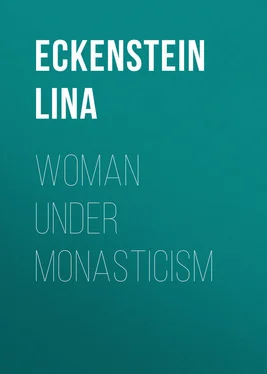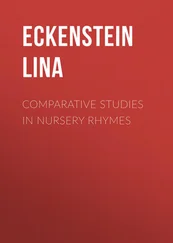Lina Eckenstein - Woman under Monasticism
Здесь есть возможность читать онлайн «Lina Eckenstein - Woman under Monasticism» — ознакомительный отрывок электронной книги совершенно бесплатно, а после прочтения отрывка купить полную версию. В некоторых случаях можно слушать аудио, скачать через торрент в формате fb2 и присутствует краткое содержание. Жанр: История, foreign_antique, foreign_prose, на английском языке. Описание произведения, (предисловие) а так же отзывы посетителей доступны на портале библиотеки ЛибКат.
- Название:Woman under Monasticism
- Автор:
- Жанр:
- Год:неизвестен
- ISBN:нет данных
- Рейтинг книги:4 / 5. Голосов: 1
-
Избранное:Добавить в избранное
- Отзывы:
-
Ваша оценка:
- 80
- 1
- 2
- 3
- 4
- 5
Woman under Monasticism: краткое содержание, описание и аннотация
Предлагаем к чтению аннотацию, описание, краткое содержание или предисловие (зависит от того, что написал сам автор книги «Woman under Monasticism»). Если вы не нашли необходимую информацию о книге — напишите в комментариях, мы постараемся отыскать её.
Woman under Monasticism — читать онлайн ознакомительный отрывок
Ниже представлен текст книги, разбитый по страницам. Система сохранения места последней прочитанной страницы, позволяет с удобством читать онлайн бесплатно книгу «Woman under Monasticism», без необходимости каждый раз заново искать на чём Вы остановились. Поставьте закладку, и сможете в любой момент перейти на страницу, на которой закончили чтение.
Интервал:
Закладка:
Besides the reminiscences of the early period which have survived in saint legend, traditions and customs of the same period have lived on in the worship of the Virgin Mary. The worship of the Virgin Mary was but slightly developed in Romanised Gaul and Keltic Britain, but from the beginning of the sixth century it is a marked feature in the popular creed in those countries where the German element prevailed.
As Mrs Jameson says in her book on the legends of the Madonna: ‘It is curious to observe, as the worship of the Virgin mother expanded and gathered in itself the relics of many an ancient faith, how the new and the old elements, some of them apparently most heterogeneous, became amalgamated and were combined into the earlier forms of art… 12 12 Jameson, Legends of the Madonna , 1857, Introd. xix.
.’
Indeed the prominence given to the Virgin is out of all proportion to the meagre mention of her in the gospels. During the early Christian period she was largely worshipped as a patron saint in France, England and Germany, and her fame continued steadily increasing with the centuries till its climax was reached in the Middle Ages, which witnessed the greatest concessions made by the Church to the demands of popular faith.
According to Rhys 13 13 Rhys, J., Lectures on the origin and growth of religion as illustrated by Celtic Heathendom , 1888, p. 102.
many churches dedicated to Mary were built on spots where tradition speaks of the discovery of a wooden image, probably a heathen statue which was connected with her.
In the seventh century Pope Sergius (687-701) expressly ordered that the festivals of the Virgin Mary were to take place on heathen holy days in order that heathen celebrations might become associated with her 14 14 Frantz, C., Versuch einer Geschichte des Marien und Annencultus , 1854, p. 54 ff.
. The festivals of the Virgin to this day are associated with pilgrimages, the taste for which to the Frenchman of the Middle Ages appeared peculiarly German. The chronicler Froissart, writing about 1390, remarks ‘for the Germans are fond of performing pilgrimages and it is one of their customs 15 15 Froissart, Chronicle , c. 162, in English translation; also Oberle, K. A., Ueberreste germ. Heidentums im Christentum , 1883, p. 153.
.’
Mary then, under her own name, or under the vaguer appellation of Our Lady (Unser liebe frau, Notre Dame, de heilige maagd), assimilated surviving traditions of the heathen faith which were largely reminiscences of the mother-age; so that Mary became the heiress of mother-divinities, and her worship was associated with cave, and tree, and fountain, and hill-top, all sites of the primitive cult.
‘Often,’ says Menzel 16 16 Menzel, Christ. Symbolik , 1854, article ‘Baum.’
, ‘a wonder-working picture of the Madonna is found hung on a tree or inside a tree; hence numerous appellations like “Our dear Lady of the Oak,” “Our dear Lady of the Linden-tree,” etc. Often at the foot of the tree, upon which such a picture is hung, a fountain flows to which miraculous power is ascribed.’
In the Tyrol we hear of pictures which have been discovered floating in a fountain or which were borne to the bank by a river 17 17 Oberle, K. A., Ueberreste germ. Heidentums im Christentum , 1883, p. 144.
.
As proof of the Virgin Mary’s connection with festivals, we find her name associated in Belgium with many pageants held on the first of May. Throughout German lands the Assumption of the Virgin comes at the harvest festival, and furnishes an occasion for some pilgrimage or fair which preserves many peculiar and perplexing traits of an earlier civilization.
The harvest festival is coupled in some parts of Germany with customs that are of extreme antiquity. In Bavaria the festival sometimes goes by the name of the ‘day of sacred herbs,’ kräuterweihtag ; near Würzburg it is called the ‘day of sacred roots,’ würzelweihtag , or ‘day of bunch-gathering,’ büschelfrauentag 18 18 Menzel, Christl. Symbolik , 1854, article ‘Himmelfahrt.’
. In the Tyrol the 15th of August is the great day of the Virgin, grosse frauentag , when a collection of herbs for medicinal purposes is made. A number of days, frauentage , come in July and August and are now connected with the Virgin, on which herbs are collected and offered as sacred bunches either on the altar of Our Lady in church and chapel, or on hill-tops which throughout Germany are the sites of ancient woman-worship 19 19 Ibid., article ‘Frauenberg’; also Oberle, K. A., Ueberreste germ. Heidentums im Christentum , 1883, p. 38.
. This collecting and offering of herbs points to a stage even more primitive than that represented by offerings of grain at the harvest festival.
In a few instances the worship of Mary is directly coupled with that of some heathen divinity. In Antwerp to this day an ancient idol of peculiar appearance is preserved, which women, who are desirous of becoming mothers, decorate with flowers at certain times of the year. Its heathen appellation is lost, but above it now stands a figure of the Virgin 20 20 Rochholz, Drei Gaugöttinnen , 1870, p. 81, calls it Walburg; Reinsberg-Düringsfeld, Traditions et légendes de la Belgique , 1870, p. 286, calls it Fro or Frigg.
.
Again we find the name of Mary joined to that of the heathen goddess Sif. In the Eiffel district, extending between the rivers Rhine, Meuse and Mosel, a church stands dedicated to Mariasif, the name of Mary being coupled with that of Sif, a woman-divinity of the German heathen pantheon, whom Grimm characterizes as a giver of rain 21 21 Simrock, K., Handbuch der deutschen Mythologie , 1887, p. 379; also Grimm, J., Deutsche Mythologie , 1875, p. 257.
. The name Mariahilf, a similar combination, is frequently found in south Germany, the name of Mary as we hope to show further down being joined to that of a goddess who has survived in the Christian saint Hilp 22 22 Comp. below, p. 35.
.
These examples will suffice to show the close connection between the conceptions of heathendom and popular Christianity, and how the cloak of heathen association has fallen on the shoulders of the saints of the Christian Church. The authorities at Rome saw no occasion to take exception to its doing so. Pope Gregorius II. (590-604) in a letter addressed to Melitus of Canterbury expressly urged that the days of heathen festival should receive solemnity through dedication to some holy martyr 23 23 Bede, Ecclesiastical History , 1, ch. 30.
. The Christian saint whose name was substituted for that of some heathen divinity readily assimilated associations of the early period. Scriptural characters and Christian teachers were given the emblems of older divinities and assumed their characteristics. But the varying nature of the same saint in different countries has hardly received due attention. St Peter of the early British Church was very different from St Peter who in Bavaria walked the earth like clumsy good-natured Thor, or from St Peter who in Rome took the place of Mars as protector of the city. Similarly the legends currently told of the same saint in different countries exhibit markedly different traits.
For the transition from heathendom to Christianity was the work not of years but of centuries; the claims made by religion changed, but the underlying conceptions for a long time remained unaltered. Customs which had once taken a divine sanction continued to be viewed under a religious aspect, though they were often at variance with the newly-introduced faith. The craving for local divinities in itself was heathen; in course of time the cult of the saints altogether re-moulded the Christianity of Christ. But the Church of Rome, far from opposing the multitude of those through whom the folk sought intercession with the Godhead, opened her arms wide to all.
Читать дальшеИнтервал:
Закладка:
Похожие книги на «Woman under Monasticism»
Представляем Вашему вниманию похожие книги на «Woman under Monasticism» списком для выбора. Мы отобрали схожую по названию и смыслу литературу в надежде предоставить читателям больше вариантов отыскать новые, интересные, ещё непрочитанные произведения.
Обсуждение, отзывы о книге «Woman under Monasticism» и просто собственные мнения читателей. Оставьте ваши комментарии, напишите, что Вы думаете о произведении, его смысле или главных героях. Укажите что конкретно понравилось, а что нет, и почему Вы так считаете.












